Providing your chickens with the right nutrition is essential for their health and productivity. Crafting chicken feed can be rewarding if you aim for an organic approach. This article delves into DIY organic chicken feed recipes tailored for every stage of your flock’s life – from starters and growers to broilers and layers. Discover how to nourish your feathered friends naturally, ensuring they thrive and lay the foundation for wholesome, farm-fresh eggs and meat.
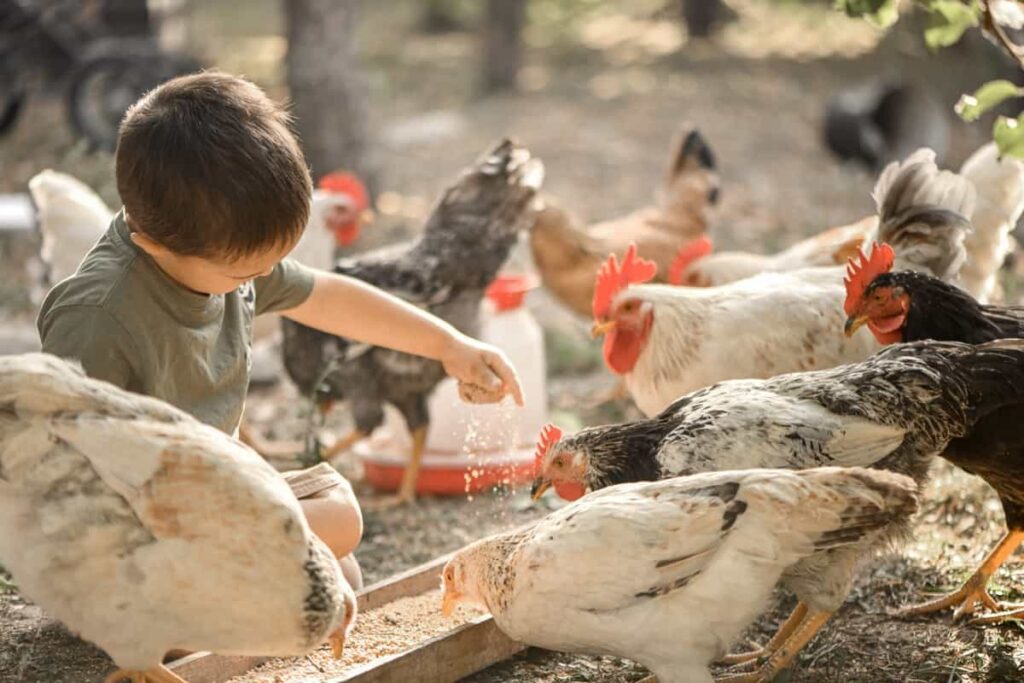
What is Organic Chicken Feed?
Creating a well-balanced chicken feed tailored to each developmental stage is vital for optimal growth and production. Just like humans, chickens have changing nutritional requirements. During their chick phase (up to 6 weeks), they need 22-24% protein for healthy growth. As adolescents (6-22 weeks), protein remains important, though at 16-18% levels.
For egg layers (22 weeks and beyond), sustaining eggshell strength demands added calcium and minerals alongside 16-18% protein. Meat-focused chickens need increased protein. Studying commercial feed can provide percentage benchmarks for macronutrients and micronutrients, but customization is essential based on availability, cost, and regional factors.
Organic Chicken Feed: An Introduction to Organic Poultry Nutrition
Organic chicken feed embodies a natural and sustainable approach to poultry nutrition. By utilizing organic ingredients devoid of synthetic chemicals, genetically modified organisms, and pesticides, this practice prioritizes the chickens’ well-being and the quality of the end product. A balanced diet tailored to each life stage ensures optimal growth, egg production, and overall health. This commitment to organic poultry nutrition benefits the chickens and resonates with consumers seeking ethically raised and environmentally friendly food options.
Importance of Organic Feed for Chickens: Benefits and Advantages
- Enhanced Nutritional Value: Organic feed offers higher nutrients, promoting chicken growth, health, and egg production.
- Reduced Chemical Exposure: Organic feeds omit synthetic pesticides and additives, minimizing chemical exposure to chickens and consumers.
- Healthier Birds: Natural ingredients boost chickens’ immune systems, reducing the need for antibiotics and enhancing overall well-being.
- Richer Omega-3 Content: Organic diets often produce eggs and meat with increased omega-3 fatty acids, offering better nutritional profiles.
- Environmental Impact: Organic practices prioritize sustainability, conserving soil, water, and ecosystems by avoiding harmful chemicals.
- Improved Flavor: Chickens fed organic diets yield meat and eggs with richer flavors, preferred by those seeking high-quality produce.
- Ethical Treatment: Organic standards emphasize humane treatment, granting chickens access to outdoor areas and better living conditions.
- Support for Local Economy: Opting for organic feeds encourages local farming, fostering community growth and reducing carbon footprint.
- Consumer Confidence: Organic labeling assures consumers of healthier, more ethical poultry products.
- Long-Term Sustainability: Organic practices ensure long-term poultry farming viability by maintaining soil fertility and biodiversity.
In case you missed it: Project Report of Layer Chicken Farming: Production Economics, Cost and Profit Analysis
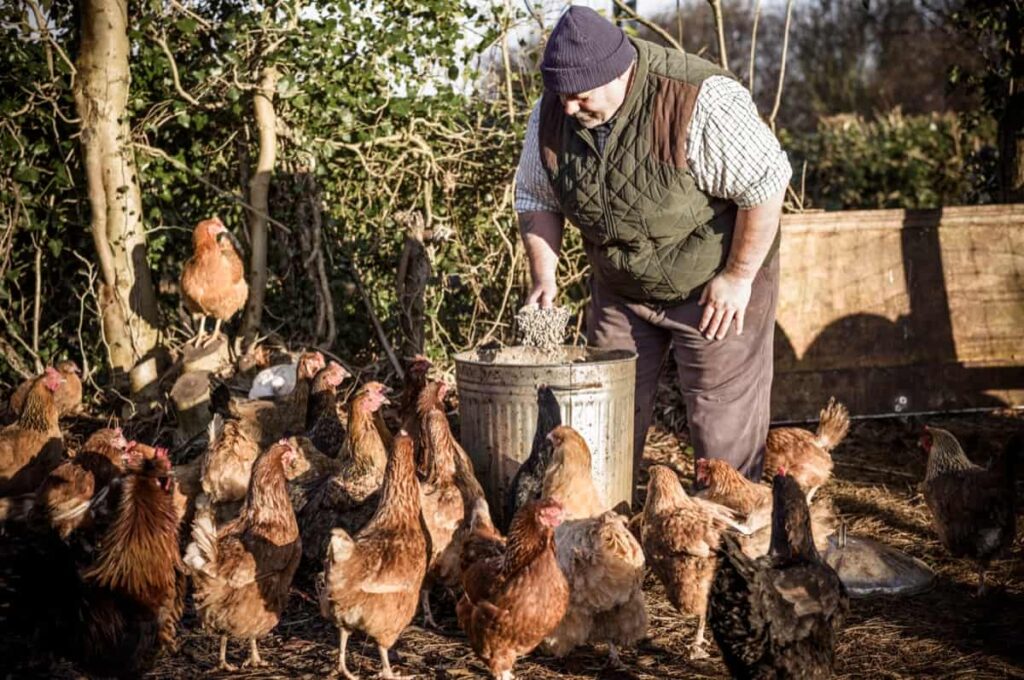
Choosing the Right Starter Feed for Chicks: Nutritional Requirements and Considerations
- Balanced Nutrients: A good starter feed must have balanced protein, energy, vitamins, and minerals to support chicks’ rapid growth and development.
- Protein Content: Chicks require higher protein levels in their diet for initial growth. Look for starter feeds with around 20-24% protein content.
- Amino Acids: Essential amino acids like methionine and lysine are crucial for chick growth. Some feeds may supplement these amino acids to ensure optimal development.
- Digestible Carbohydrates: Carbohydrates provide energy for chicks. Easily digestible sources like grains help sustain their active metabolism.
- Vitamins and Minerals: Adequate vitamins (A, D, E, K, B-complex) and minerals (calcium, phosphorus) are essential for bone development and overall health.
- Grit and Fiber: Grit aids in chick digestion, especially if they aren’t free-ranging. A small amount of fiber supports their digestive tract.
- Prebiotics and Probiotics: Some starter feeds include prebiotics and probiotics to promote gut health and boost immunity.
- Medication: Depending on your preferences and needs, you might choose feeds with or without medications like coccidiostats for disease prevention.
- Organic Options: If you’re pursuing organic farming, opt for organic starter feeds to ensure the same benefits without synthetic additives.
- Feeding Practices: Providing fresh water alongside the starter feed is crucial. Monitor chick behavior and adjust feeding based on their appetite and growth.
Organic Starter Feed Formulation: Ingredients and Composition
Crafting an organic starter feed demands meticulous ingredient selection to cater to young chicks’ nutritional needs. The formulation typically includes protein-rich sources like soybean meal, ensuring robust growth and feather development. Whole grains such as corn and wheat provide energy, while flaxseed offers essential omega-3 fatty acids for overall health.
Organic vitamins and minerals, often derived from alfalfa and kelp, support bone formation and immune system function. Prebiotics and probiotics may be incorporated to enhance gut health. Organic starter feeds avoid synthetic additives and antibiotics, aligning with sustainable and ethical farming practices.
Feeding Organic Grower Feed to Pullets: Meeting Nutritional Needs During Growth Phase
Feeding organic grower feed to pullets during their growth phase ensures their proper development into healthy egg-laying hens. This phase demands a balanced diet rich in proteins and nutrients. Organic grower feed typically contains grains like corn, wheat, peas, and oats, offering a combination of energy and protein crucial for growth.
In case you missed it: Project Report of Broiler Chicken Farming: Production Economics, Cost and Profit Analysis
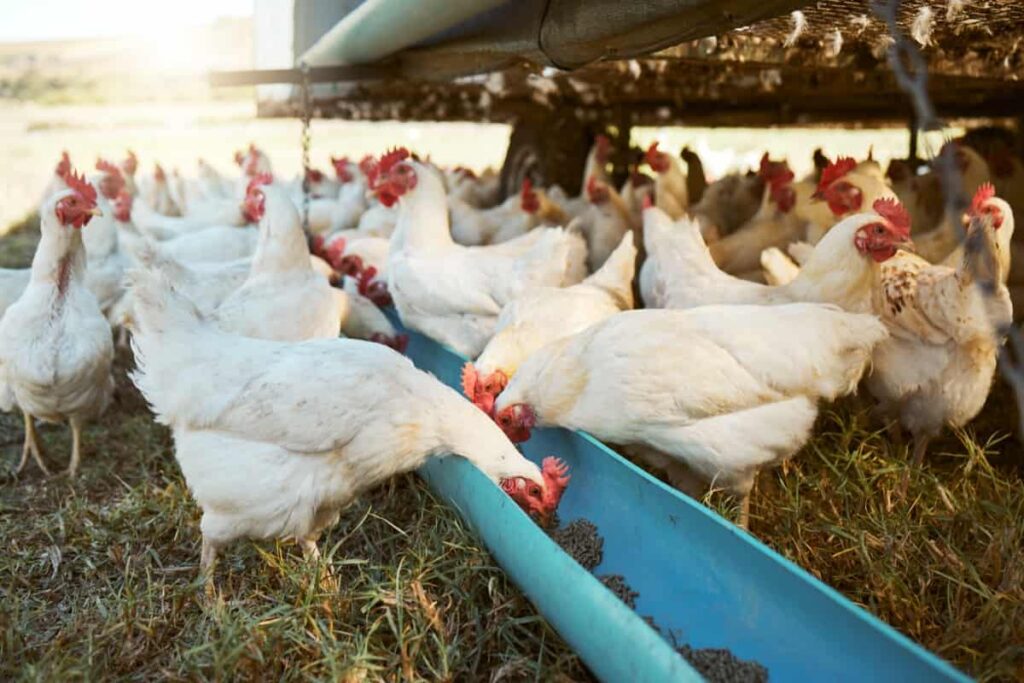
Supplements like calcium sources (Aragonite, oyster shell) ensure strong eggshells, while minerals (kelp, fish meal) support bone health. Natural additives such as probiotics, herbs like oregano and cinnamon, and omega-3-rich flaxseed aid digestion, boost immunity and promote overall well-being. Providing pullets with the right organic nutrition sets.
Optimal Nutrition for Growing Chickens: Essential Nutrients and Supplements
Creating your own DIY organic chicken feed is an art that harmonizes with the nutritional demands of your poultry. To cultivate a balanced diet, you must cater to each life stage’s specific requirements. Essential nutrients include protein, which is crucial for muscle and egg production, derived from alfalfa, wheat, and insects.
Amino acids like methionine and lysine, necessary for growth, can be supplemented with foods such as flaxseed and fish meal. Fats in flaxseed and fish meal support energy and vitamin absorption. Carbohydrates, derived from grains like corn and wheat, provide energy. Vitamins, notably A, D, E, and B-complex, and minerals like calcium and phosphorus, ensure overall well-being. Customizing your mix, considering factors like age and purpose, empowers you to optimize your flock’s health and productivity.
Transitioning from Starter to Grower Feed: Guidelines and Recommendations
- Timing: Start the transition around eight weeks when pullets are becoming adolescents.
- Gradual Change: Mix starter and grower feeds over 7-10 days. Begin with 75% starter and 25% grower, then adjust gradually to 50-50, and finally, 25% starter and 75% grower.
- Protein Levels: Starter feed has about 20-24% protein, while grower feed has around 16-18%. Decreasing protein prevents rapid growth, avoiding skeletal issues.
- Feeding Behavior: Monitor their appetite and growth during the transition. Ensure they eat enough grower feed but don’t overeat.
- Week 1: 75% starter feed + 25% grower feed
- Week 2: 50% starter feed + 50% grower feed
- Week 3: 25% starter feed + 75% grower feed
Organic Layer Feed for Laying Hens: Meeting Calcium and Protein Requirements
Organic layer feed for laying hens sustains egg production while maintaining bird health. Feed must incorporate sources like aragonite, oyster shell, and feeding limestone to meet calcium requirements for sturdy eggshells. Calcium levels are typically around 3.5–4.5% in the feed. About 16–18% protein content supports egg production and body maintenance. Sources like soybean meal, fish meal, and alfalfa meal contribute protein.
Omega-3 fatty acids in flaxseed and fish meal enhance egg quality. Vitamins A, D, and E are crucial for reproductive health and eggshell formation. Probiotics aid digestion and overall well-being. An example formulation could include 30% corn, 30% wheat, 20% peas, 10% oats, 5% flaxseed, and 5% fish meal, supplemented with calcium sources, vitamins, and probiotics.
Balancing Nutrients in Layer Feed: Vitamins, Minerals, and Amino Acids
Balancing nutrients in layer feed is for optimal egg production and hen health. Vitamins like A, D, and E ensure strong eggshells and reproductive health. B-complex vitamins aid metabolism and energy utilization. Minerals such as calcium, phosphorus, and magnesium are essential for bone strength and eggshell quality. Amino acids, including lysine and methionine, are building blocks for egg proteins. Omega-3 fatty acids from sources like flaxseed enrich egg quality.
In case you missed it: Country/Free Range Chicken Farming Project Report: Business Plan, Investment, Profit, and Loan in India
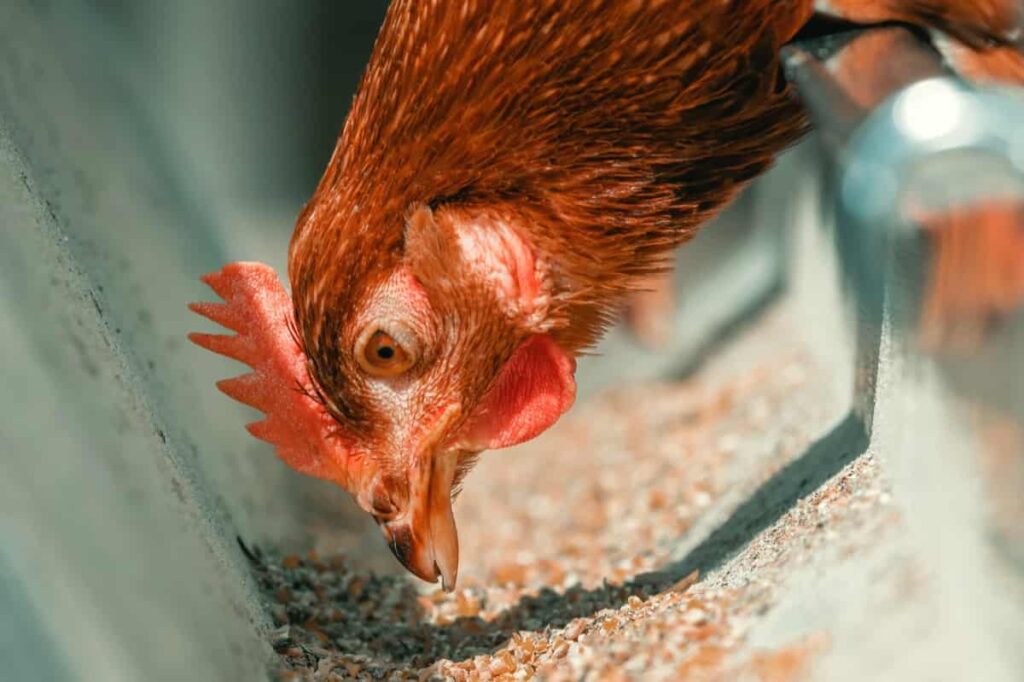
Probiotics enhance gut health, supporting nutrient absorption and overall well-being. Selenium and zinc contribute to antioxidant defenses. Iron supports blood health and oxygen transport. Copper is necessary for eggshell pigment production. Optimal levels of each nutrient prevent deficiencies, ensure egg quality, and promote the longevity of laying hens.
Feeding Organic Layer Pellets vs. Crumbles: Pros and Cons
Layer Pellets
Pros
- Convenience: Pellets are less likely to create waste as hens can’t easily sort through them.
- Uniform Nutrition: Pellets consistently contain balanced nutrients, ensuring optimal intake.
- Reduced Dust: Pellets generate less dust than crumbles, improving conditions.
Cons
- Size Preference: Some hens may not prefer larger pellets, leading to selective eating.
- Inadequate Intake: Hens with smaller beaks might struggle with larger pellets, affecting consumption.
Layer Crumbles
Pros
- Ease of Consumption: Smaller particle size suits hens of all sizes, promoting better intake.
- Preference: Hens might prefer crumbles due to familiarity and ease of eating.
- Less Processing: Crumbles involve less processing than pellets, potentially retaining more nutrients.
Cons
- Sorting: Hens can selectively eat favored ingredients, potentially resulting in imbalanced nutrition.
- Dust Creation: Crumbles generate more dust, leading to messier conditions and potential respiratory issues.
Supplementing Layer Feed with Oyster Shells: Promoting Strong Eggshells
Supplementing layer feed with oyster shells enhances eggshell strength and health in laying hens. Oyster shells are a source of calcium, which is crucial for forming sturdy eggshells. As hens lay eggs, they require additional calcium to prevent the depletion of their calcium stores. Providing oyster shells separately allows hens to regulate their intake, ensuring they receive adequate calcium without overloading on layer feed. This supplementation promotes optimal eggshell quality, reduces the risk of thin or cracked shells, and supports the well-being of laying hens.
In case you missed it: Free-Range Chicken Farm Operations Management: Month-Wise Maintenance For Better Profits
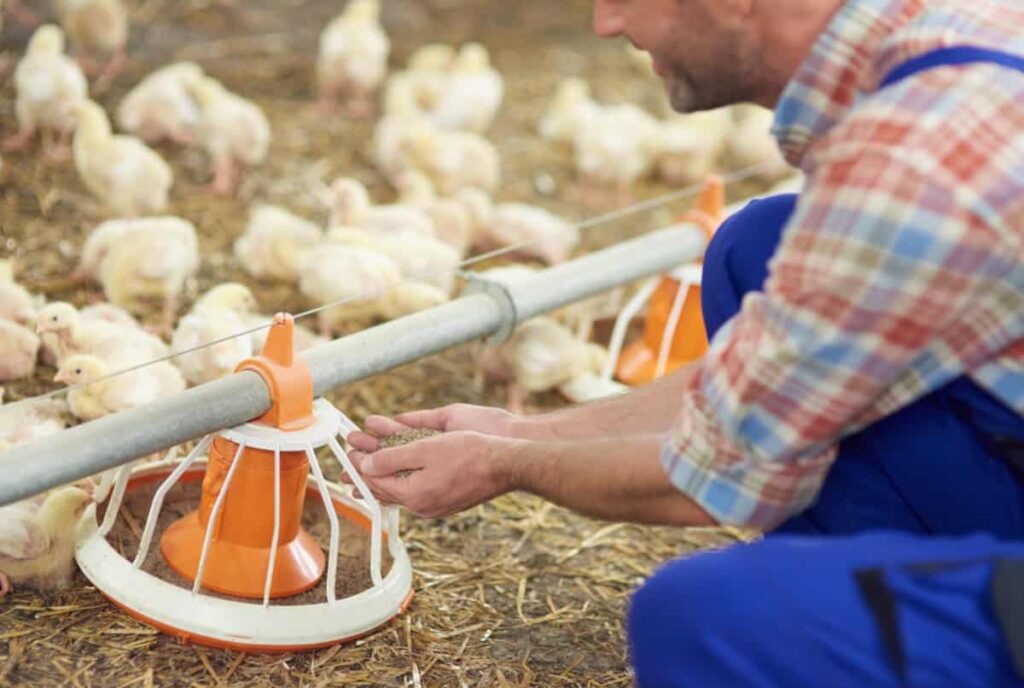
Organic Feed for Broiler Chickens: High-Protein Formulation for Meat Production
Creating DIY chicken feed on a larger scale requires a heavy-duty feed or flour mill. Alternatively, a hand-operated meat grinder can be used for smaller flocks. Proper storage bins with partitions and lids are crucial for maintaining the freshness of grains, and regular cleaning prevents pest infestations.
Feed texture varies based on age: mash is suitable for chicks up to 8-12 weeks, crumble from 12 weeks until egg-laying, and pellets for birds at least 18 weeks old. Consider fermented or sprouted grains for improved digestion. While providing treats, ensure they don’t exceed 10% of the daily diet and offer variety like oats, grubs, fruits, and leafy greens. Avoid feeding harmful foods such as chocolate, onions, and raw beans.
Feeding Organic Scratch Grains to Chickens: Treats or Main Diet?
Feeding organic scratch grains to chickens is best approached as a treat rather than a main diet. Scratch grains, typically a mix of whole grains like corn, wheat, and barley, need more balanced nutrition for complete health. While chickens enjoy scratching and pecking at them, relying solely on scratch grains leads to nutrient deficiencies. They can be offered in moderation to supplement a well-formulated layer feed. A balanced feed layer provides essential nutrients for egg production and overall well-being.
Understanding Non-GMO Chicken Feed: Differences from Organic Options
Non-GMO chicken feed is distinct from organic options, focusing solely on the absence of genetically modified organisms. It avoids feed ingredients derived from genetically engineered crops. While non-GMO feed restricts GMOs, it doesn’t guarantee other organic practices like synthetic pesticide or antibiotic avoidance. On the other hand, organic chicken feed encompasses a broader scope, excluding GMOs, while ensuring organic ingredients are free from synthetic chemicals, antibiotics, and pesticides.
DIY Organic Chicken Feed Recipes: Customizing Feeds for Your Flock’s Needs
- 30% Corn, 30% Wheat, 20% Peas, 10% Oats, and 10% Fish Meal: This blend offers a balanced mix of carbohydrates and protein crucial for growth. Corn and wheat provide energy, peas add protein, while oats contribute to balanced nutrition.
- Aragonite or Feeding Limestone, Oyster Shell: These sources are rich in calcium, vital for strong eggshells, and overall health.
- Grit: Aids digestion by grinding food in the gizzard.
- Salt: Sodium supports growth and other physiological processes.
- Probiotic: Promotes a healthy gut and efficient digestion.
- Crab Meal, Flaxseed, Fish Meal: These ingredients offer essential proteins, omega-3 fatty acids, and minerals, supporting overall well-being.
- Mineral Supplement, Kelp, Cultured Yeast: Ensures vital minerals, vitamins, and enzymes are present for bone health, egg production, and digestion.
- Duckweed: A protein-rich addition to the diet.
- Cinnamon, Oregano, Cayenne: These natural additives contribute antibacterial, immune-boosting, and circulation-enhancing properties, especially beneficial during colder months.
In case you missed it: Sustainable Poultry Farming: Benefits and How to Reduce Your Carbon Footprint with Chickens
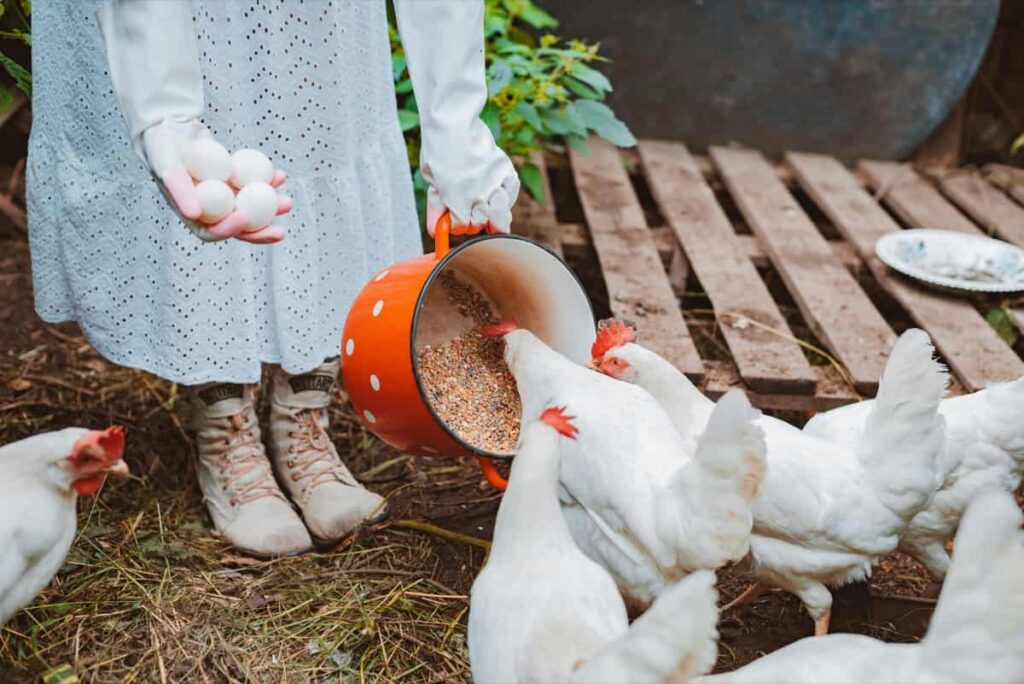
Best Organic Chicken Feeds Available in the Market
- Kalmbach Feeds Organic Harvest 17% Protein Layer Chicken Feed: This USDA-certified feed contains 17% protein, vitamin D, and omega-3 for optimal egg-laying and nutritional quality. It’s designed for hens and supports their immune and digestive health.
- Modesto Milling Organic Layer Crumbles Poultry Feed: A budget-friendly option, this feed offers 17% protein without corn, soy, or GMOs. It promotes balanced diets for free-range and coop-raised birds and is suitable for chickens and ducks.
- Eggland’s Best 19% Protein Organic Starter-Grower Crumbles: Ideal for chicks’ initial development, this feed is vegetarian, pasteurized, and free from hormones and antibiotics. It contains vitamins B5 and A for immune support.
- Scratch and Peck Feeds Organic Grower Poultry Feed: This feed, suitable for 2-5-month-old chicks, ducks, and goslings, contains minerals, vitamins, and omega-3 oils. It’s non-GMO, USDA-certified, and supports healthy growth.
- FLYGRUBS Black Soldier Fly Larvae Chicken Feed: Rich in calcium, this environmentally-friendly option contains oven-dried black soldier fly larvae. It’s intended as a supplement to other feeds and promotes stronger eggshells.
- Scratch and Peck Feeds Organic Layer 16% Poultry Feed: Formulated for laying hens, this feed contains 16% protein and calcium for strong eggshells. It’s free from soy and corn, suitable for ducks and waterfowl.
- Kalmbach Feeds Organic 20% Starter Grower Poultry Feed: A starter feed with 20% protein for young chicks, this option supports muscle development and immune health.
- Eggland’s Best 17% Protein Layer Mini-Pellets Chicken Feed: This vegetarian feed with 17% protein is designed for egg layers, is pasteurized, and contains fewer saturated fats.
- Scratch and Peck Feeds Organic Starter Chicken & Duck Feed: Suitable for chicks and ducklings, this feed promotes healthy immune systems with omega-3 oils, amino acids, and probiotics.
- Mile Four 16% Organic Layer Chicken & Duck Feed: With 16% protein and no corn or soy, this feed supports layers’ strong bones and egg production.
Conclusion
Organic chicken feed is essential for optimal health and egg production. Tailoring feeds for each growth stage, from starter to broiler and layer, ensures proper nutrition. DIY recipes with grains, seeds, and supplements promote well-being, strong eggshells, and sustainable farming practices. Choose wisely for thriving flocks.
- How to Raise Pigs in Your Own Backyard: A Comprehensive Guide
- Budget Friendly Sheep Shed Ideas: Cheap and Low-Cost Tips
- How Much Do Cattle Farmers Make: Revenue Streams in Cattle Farming
- Management Pests and Diseases in Your Cotton Field
- Sheep Farming Business Plan for Beginners
- Aquaponic Farming at Home: A Step-By-Step Guide
- Profitable Village Farming Business Ideas in 2024
- High-Yield Aquaculture: Fast-Growing Fish for Farming
- Effective Fish Pond Construction Techniques for Beginners
- Irrigation and Water Management in Pineapple Farming
- Blossom to Harvest: Mastering Flowering and Pollination in Papaya Farming
- Pig Fattening Essentials: From Selection to Sale for Beginners
- Raising Wagyu Cattle: A Complete Guide for Premium Beef Production
- Soil Types and Their Water Holding Capacity
- Optimizing Irrigation Schedules for Coconut Groves for Enhanced Yield
- Espresso Your Garden: Coffee Grounds for Healthier Acid-Loving Plants
- The Best Soil Mix for Snake Plants: How to Mix Your Own Snake Plant Soil
- Green Thumb Success: Expert Tips for Cultivating Greenhouse Beans All Year Round
- Bloom All Year Round: The Ultimate Guide to Indoor Hyacinth Care
- Eco-Friendly Gardening: How to Make Liquid Fertilizer from Kitchen Waste
- Ultimate Guide to Grow Anise in Pots: Explore Seed Propagation to Harvesting
- Guide to Raising Chester White Pigs: Discover Breed Facts to Growth Management
- Mastering the Elegance: The Ultimate Guide to Weeping Cherry Tree Care, Planting, and Maintenance
- Ultimate Guide to Planting Garlic in Grow Bags: Growing Strategies for Beginners
- How to Fix Spider Plant Leaf-Related Problems: Natural and Organic Remedies
- 10 Reasons Why Your Tulsi Plant is Shedding Leaves: Home Remedies and Solutions
- Optimizing Growth and Yield: The Advantages of Palm Bunch Ash Fertilizer
- Utilizing Neem Oil Extract as a Natural Pesticide for Hydrangea
- From Soil to Harvest: Various Ways in Which Farmers Can Use AI Tools
- Steps to Encourage and Induce Citrus Flowers: A Comprehensive Guide
- How to Fix Snake Plant Leaf-Related Issues: Natural and Organic Remedies
- Transform Your Garden into a Fragrant Oasis with Raat Ki Rani (Night Blooming Jasmine)
- Discover the Ideal Chicken Breeds for Philippine Farms
- How to Create a Poultry Egg Farm Business Plan for Profits
- Grow Lemon Cucumbers Like a Pro: Insider Techniques for Bountiful Yields
- Ultimate Guide to Caring for Your Pink Princess Philodendron: Tips for Thriving Variegation
